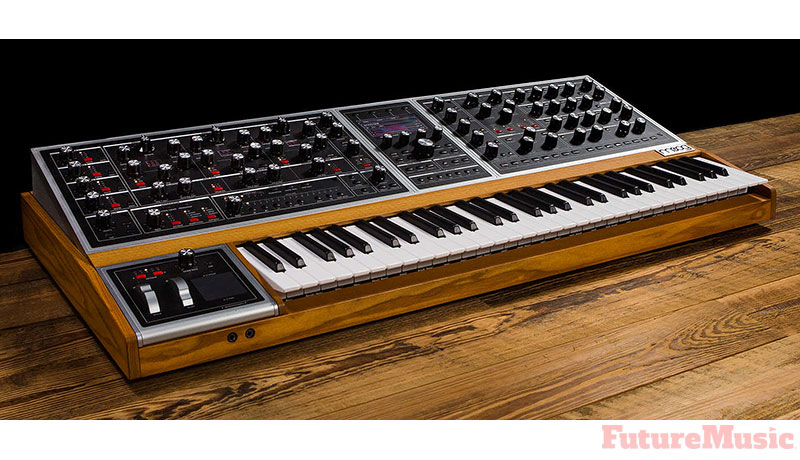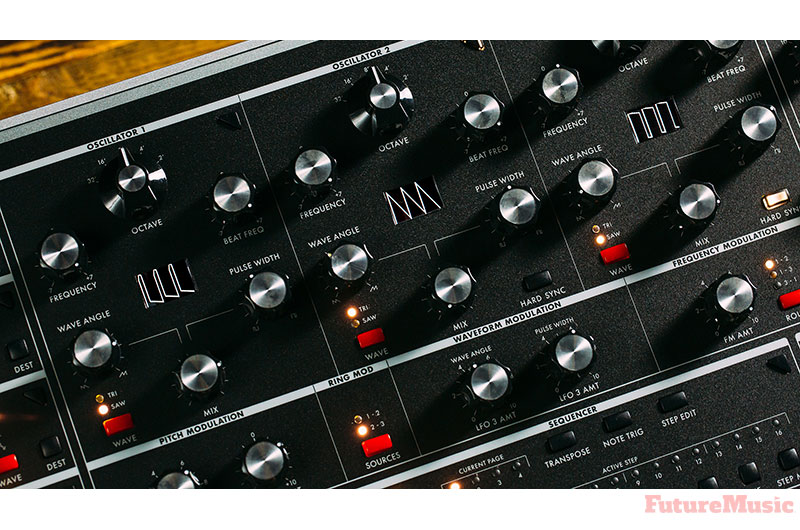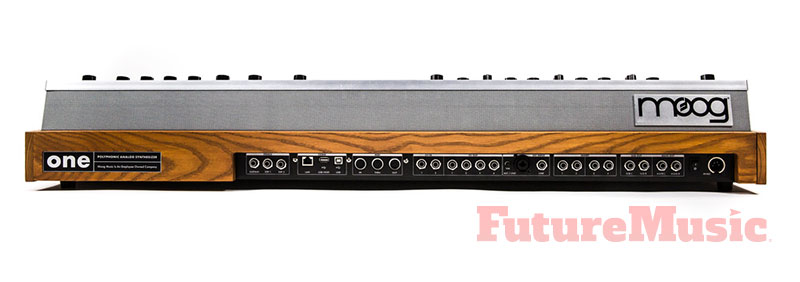Moog Music, has announced the Moog One, a tri-timbral, polyphonic, analog synthesizer. With a topology based in new patent-pending Moog technology, Moog One builds on decades of technological tradition while pushing the limits of what is technically possible. Available in 8-voice or 16-voice configurations, each individual Moog One voice circuit contains an analog signal path more powerful than a Minimoog Voyager, harnessing the power of three newly-designed dual-output analog VCOs with ring mod and FM, two independent analog filters, a dual source analog noise generator, analog mixer with external audio input, four LFOs, and three envelope generators. Each of Moog One’s three analog timbres is an independently addressable poly synth, each with its own sequencer, arpeggiator, and onboard effects library–including a suite of professional reverbs from Eventide.

Every Moog One preset is a self-contained creative environment, recalling a unique configuration of parameter settings, sequencer programs, arpeggiator patterns, key splits, modulation routings, effects combinations, voice allocations, and timbral assignments. 64 presets can be loaded into the front panel Performance Set module for instant selection, while thousands of presets can be stored to the instrument’s internal browser, complete with searchable categories, tags, and notations.
Three newly-designed analog VCOs, Two distinctive analog filters, and a dual source analog noise generator
With over 200 front panel knobs and switches, Moog One is designed to simplify the process so that artistry is not hindered by technology. From the Destination button that invites the creation of quick modulation assignments, to the onboard Mod Matrix that provides visual feedback for every possible combination of synthesis components within the system, each design element of Moog One has been chosen with care to inspire creativity through the freedom of unrestrained sonic exploration.

Taking support to new levels, Moog One features a rear panel ethernet port that enables the synthesizer to connect directly to its source and “Phone Home” to the Moog Factory in Asheville, NC, allowing Moog technicians to perform remote diagnostics and service routines should they ever be needed. This direct real-time connection is mirrored through moogmusic.com, a new portal for communication that empowers visitors to engage directly in conversation with us here inside the Moog Factory — ask questions, give feedback, discover new techniques, share experiences, and learn more about Moog synthesizers.
Available in 8-voice and 16-voice configurations, Moog One’s polyphonic sound engine is built on the most powerful synthesizer architecture ever employed by a Moog instrument. Per voice, Moog One offers three newly-designed analog VCOs, two independent analog filters, a dual source analog noise generator, analog mixer with external audio input, four LFOs, and three envelopes. To deliver an infinitely inspiring performance experience, each of the three timbres can be easily split or layered across Moog One’s expressive 61-note keyboard, each with its own sequencer, arpeggiator, and onboard effects library–including a suite of professional reverbs from Eventide.

Secured in a hand-finished Ash cabinet and aluminum enclosure, Moog One’s front panel is equipped with 73 knobs and 144 buttons, inviting physical connection with every sound shaping and performance control. Extended functionality is easily accessed via a per-module |More| button that brings additional parameters into focus using the Moog One center-panel LCD to ensure the most transparent and expedient sound creation experience possible.
Moog One Specifications:
» OSCILLATORS (X3): Selectable Sawtooth wave with variable reset time or Triangle wave with variable rise and fall times, variable-width Pulse wave, Octave (32’, 16’, 8’, 4’, 2’), Frequency (+/- 7 semitones), Beat Frequency (+/- 7Hz), Wave Angle (Triangle and Saw), Pulse Width, Mix (blends the selected Triangle or Saw wave with the Pulse wave), FM routing and amount, and Hard Sync
» RING MODULATOR: Selectable routing (1-2 or 2-3)
» DUAL SOURCE NOISE GENERATOR: Selectable sources (Red+White, Red+Purple, and White+Purple) with Color Mix and dedicated ARS envelope
» MIXER: Independent levels and filter routing for OSC 1, OSC 2, OSC 3, RING MOD, NOISE, and EXT in.
» FILTERS: State-Variable Filter; Ladder Filter (Mixable, Parallel or Series operation)
» STATE VARIABLE: Two 12dB per octave filters operating as one filter, configurable in NOTCH, BP, LP, and HP – with 12dB or 24dB slopes; Cutoff, Resonance, etc.
» LADDER FILTER: Moog Ladder Filter with HP or LP options, and selectable filter slopes (6db, 12db, 18dB, or 24dB); Cutoff, Resonance, etc.
» ENVELOPES (X3): Delay, Attack, Hold, Decay, Sustain, and Release; variable curves per stage, plus multi-triggering, looping, latching, and sync
» LFOS (X4): Dual-waveform categories with variable shapes (Triangle to Sine, variable-width Pulse, Saw to Ramp, S&H to Noise), assignable and variable transitions; fade-in/fade-out times, repeat count, phase start, etc.
» GLIDE: Selectable glide type (LCR, LCT, EXP), gated glide, legato glide, glissando
» ARPEGGIATOR: Per SYNTH with octave range, pattern, direction, pendulum features, gate time, sync, etc.
» SEQUENCER: 64-Step per-SYNTH sequencer with step-editing and modulation capabilities
» SYNTH EFFECTS: Dedicated in-line effect for SYNTH 1, SYNTH 2, and SYNTH 3 (When disengaged, the signal path is 100% analog)
» MASTER EFFECTS: Dual mono sends with stereo return, or single stereo send with stereo return. (Accessible by all three SYNTHS – Eventide Reverbs are available on the Master Bus only)
» BROWSER: Stores tens of thousands of PRESETS and TIMBRES with definable Categories, Tags and Labels to aid search results. TIMBRES can be loaded to and played by any SYNTH
» PERFORMANCE SETS: Create, save, and manage up to 128 Performance Sets offering single-button access to up to 64 PRESETS
» SETTINGS: Access to pages for managing Libraries, Tuning features, plus Utilities such as updates, configuring ins and outs, etc.
» MOD MATRIX: Provides the ability to map modulation sources to destinations at will, using either controllers or addressable transforms to articulate the modulation signal
» VOICE ALLOCATION: Mono or Poly voice count per SYNTH, unison/mono detune (48 oscillator max.), Chord Memory, plus voice stealing/sharing options
» SNAPSHOT, COMPARE: Built-in tools for saving and comparing during programming
» VCA SECTION: VCA level per SYNTH, Pan per SYNTH
» OUTPUT SECTION: Master Volume and Headphones volume controls
» AUDIO OUTPUTS: Main L, Main R (1/4″ TRS; TS compatible)
» SUB OUTPUTS: Sub 1, Sub 2 (1/4″ TRS; TS compatible)
» AUDIO INSERTS: Insert 1, Insert 2, Insert 3, Insert 4 (1/4″ TRS Send / Returns- Can be used as mono outs)
» EXTERNAL MIC/LINE INPUT: » XLR + 1/4″ TRS combo jack with trim knob
» EXTERNAL LINE INPUT: 1/4″ TRS (TS compatible)
» HEADPHONES: 2x Stereo 1/4″ jacks (located on the front edge of the Left Hand Controller)
» CONTROL VOLTAGE INPUTS: CV IN 1, CV IN 2 (1/4″ TS)
» CONTROL VOLTAGE OUTPUTS: CV OUT 1, CV OUT 2, CV OUT 3, CV OUT 4 (1/4″ TS)
» PEDAL INPUTS: Sustain, EXP 1, EXP 2, (1/4″ TRS; configurable through the Modulation Matrix, or as CV Inputs.)
Moog Music’s Moog One costs $5999 for the 8-Voice model and $7999 for the 16-Voice model, both units should be available by November 1, 2018.
Moog Music






